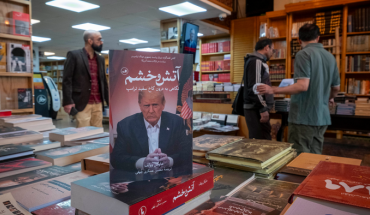In the news media and the prevailing political discourse, Iran is often portrayed as a closed society. Characterizations of Iran as a theocratic state, fundamentalist society, and a rogue nation depict Iran as an “Islamic” totalitarian state devoid of any freedom and trappings of “civil society.” At the same time, cinéphiles the world over applaud the work of Iranian filmmakers. One can cite numerous other examples of robust cultural activities in Iran.
Iran’s popular culture and media landscape are not only vast and complex, but are shot through with paradoxes and contradictions. One of these paradoxes is the proliferation of a largely secular popular culture that has emerged out of the very context in which the state has deployed various “Islamization” projects throughout society. This is not to suggest that the state has not been successful in launching institutions and policies to propagate its version of Islamic culture. Nor does this necessarily mean that all forms of religious popular culture are products of the state. Understanding this context requires analytical work that carefully considers the state’s cultural policies on the one hand, and how Iranians (with varying degrees of religiosity) live their lives under the roof of the “Islamic” Republic on the other hand. Part of the context of everyday life, even in Iran, is the presence of “globalization” processes and effects. Another indispensable component of this context is communication technologies.
In order to understand communication media and popular culture in Iran, we should begin with government owned and operated IRIB (Islamic Republic of Iran Broadcasting), which, by law, is under the direct control of the office of the Supreme Leader. IRIB is a mammoth organization that covers a wide range of activities in the production and the distribution of content. Its main domestic activities include seven television channels and 14 radio networks. Its domestic broadcasting includes a variety of external television and radio services that beam programming in 27 languages. The internal broadcasting services offer a wide range of highly popular programs (e.g., entertainment, news and public affairs, and sports), which itself is far from monolithic (although the news reflects the official views of the state).
With regard to other media outlets, the commercial newspaper industry is very dynamic, with the “reformist” press in a constant tug of war, albeit often in a restrained fashion, with the authorities. Satellite dishes, though illegal in Iran, are plentiful in urban, and to some extent in rural areas as well. Iranians receive, for a nominal one-time fee, over 40 Persian-language satellite television networks from outside Iran (including the dreadful “oppositional” channels). They also receive hundreds of foreign-language satellite channels (including BBC, CNN International, Voice of America, the Bloomberg channels, and the recently launched Persian-language BBC TV). Iran was among the first countries to go online in the Middle East, and internet in Iran has become a major force socially, politically, and culturally. Presently, there are 700,000 registered blogs in Persian, which is among the top ten languages for blogging worldwide. It is estimated that by 2010 about 50% of Iranians will have at least one cellular phone (text-messaging has become a cultural and political force), and the recent introduction of very cheap “pay-as-you-go” mobile phones has pushed these numbers even higher. These are the major media components of the media landscape in Iran. With such a wide-ranging media in the present globalizing context, in a country where 70% of the population is under the age of 30, popular culture cannot help but partake in global youth culture. Here I have space to address briefly only rap music in Iran as one form of popular culture that has emerged out of this context.
Over the past four years, chafiyeh, the checkered scarf which has been a part of the iconography of the Iranian revolution, has made a comeback in Iran among two groups — Mr. Ahmadinejad and his ardent supporters, and underground rappers. This, in itself, illustrates the contradictions within Iranian society today. For one group, the chafiyeh is the symbol of revolutionary commitment, while for the other it is a hipster’s fashion accessory. Over the past four years, rap has exploded in Iran. Clearly, the production and circulation of rap music could not be possible without the new media technologies in Iran (e.g., accessible software and home studios, file sharing, Internet, cell phones). The state authorities in Iran are not pleased with the phenomenon of “underground music.” Their concern became dramatically clear when state television recently produced a controversial documentary demonizing rappers and rock musicians as devil worshipers, drug addicts, and delinquents (not unlike “moral panic” episodes in the West when punk music or rock were first embraced by youth).
The official “Islamized” media and their discourse, then, coexist with a secular popular culture that is in tune with what is globally popular, even as it is reflexive and intensely interested in its Iranian identity. Here we could say that the wider popular culture provides a space in which the demands of state Islamization through official media and the realities of (global) youth culture and media-saturated everyday life are negotiated and reconciled. In a country with a young and largely urbanized population that has easy access to communication technologies and information, such cultural dynamism is noteworthy. In the case of the chafiyeh, in any case, we find the dilemmas and contradictions of the Iranian state and the revolution of 1979 that still demand careful examination.
The Middle East Institute (MEI) is an independent, non-partisan, non-for-profit, educational organization. It does not engage in advocacy and its scholars’ opinions are their own. MEI welcomes financial donations, but retains sole editorial control over its work and its publications reflect only the authors’ views. For a listing of MEI donors, please click here.













